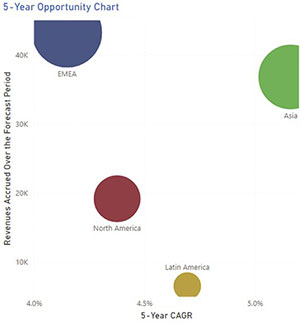

The Multi-enterprise Supply Chain Networks market research delivers current market analysis plus a five year market and technology forecast.
ARC’s research shows that the market for Multi-enterprise Supply Chain Networks (MSCN) is growing rapidly as the solutions almost always result in increased ROI. MSCN is a new name for networked applications that were already in existence. Some of the platform application providers grew incrementally out of marketplace sourcing solutions, some out of public cloud applications, and some of the risk solutions are much newer types of applications.
 In addition to providing a five-year market forecast, the Multi-enterprise Supply Chain Networks market research provides detailed quantitative current market data and addresses key strategic issues as follows.
In addition to providing a five-year market forecast, the Multi-enterprise Supply Chain Networks market research provides detailed quantitative current market data and addresses key strategic issues as follows.
In terms of supply chain digital transformations, the most advanced transformations will depend upon solving the end-to-end multi-echelon, multi-enterprise problems. With visibility to where problems are, companies can 'orchestrate' a solution, or at least mitigate, a problem. Several MSCN suppliers can use visibility to orchestrate better logistics solutions to a problem. Some vendors can use network data to optimize a better transportation solution.
Even better is a solution that could trade off manufacturing, distribution, and transportation costs to better solve an exception and enable optimized execution. Optimized execution is the key process that has been missing in SCM-deployed solution architectures.
For optimized execution, the network must run on a common data model, with a single version of the truth, in real-time, with the ability to represent multi-party and multi-tier transactions across trading partners. Furthermore, advanced risk detection is critical to optimized execution.
Advanced risk solutions continuously monitor real-time risks across hundreds of thousands of online and social media sources and then mapping those risks to the extended supply chain of a company. Risk events can also be based on real-time alerts that a shipment will arrive late to a customer.
Finally, concurrent planning would be critical for a robust optimized execution solution. Concurrent planning is the process of making and managing unified plans across multiple time horizons, business processes, and organizational boundaries at the same time. No supplier has all these capabilities.
But a supplier that could provide all these elements could allow users to build advanced supply chain control towers at a fraction of the cost and in a much quicker time frame. Currently, building advanced control towers involves complex data mapping, master data management issues, and the need to integrate different applications into a customized data mart.
Growth in this market is (also) driven by some unique characteristics of multi-enterprise supply chain networks solutions. These solutions have public cloud synergies that go beyond just being an architecture, which is quicker to implement and easier to upgrade. These benefits also go beyond making it easier to do business with companies already on the network. The benefits can include:
This market research may be purchased as a MIRA Service, an Excel Workbook, and/or as a Market Analysis Report (PDF). MIRA Services help unlock the full benefits of ARC’s market intelligence, making the data more actionable for you by adding qualitative context to our market data in an online environment unique to each customer. Regional editions include country and industry market data. Formats available are listed below:
| MIRA Services | MIRA Workbook | Market Analysis PDF | |
|---|---|---|---|
| Annual Subscription | Yes | No | No |
| Worldwide (includes regional data) | Yes | Yes | Yes |
| North America (includes regional data) | Yes | Yes | No |
| Europe, Middle East, Africa (includes regional data) | Yes | Yes | No |
| Asia (includes regional data) | Yes | Yes | No |
| Latin America (includes regional data) | Yes | Yes | No |
Table of contents for this research is shown in the following paragraphs.
The research identifies all relevant suppliers serving this market.
To speak with the author or to purchase the Multi-enterprise Supply Chain Networks Market Research, please contact us.
Learn more about ARC In-depth Research at Market Analysis
Learn more about ARC Strategic Services at Advisory Services for Industry Leaders

